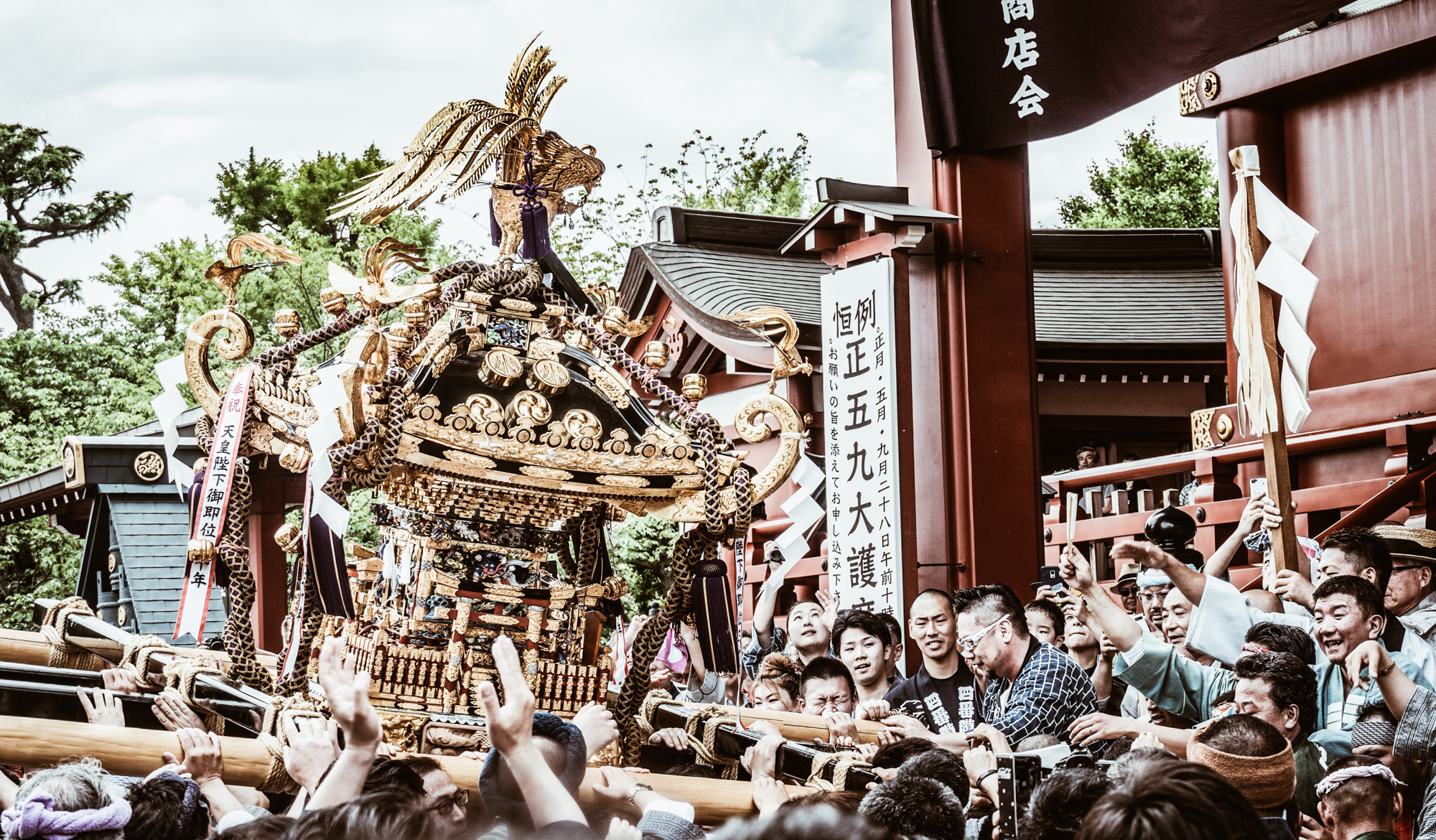Japan Tradition: Sanja Matsuri
photo credits: Yoshikazu TAKADA
Il festival dei tre templi
Il Sanja Matsuri (三社祭) è uno dei festival più famosi, più grandi è più “selvaggi” di Tokyo dedicato alla religione Shintoista. Il festival si tiene in onore di Hinokuma Hamanari, Hinokuma Takenari e Hajino Nakatomo, i tre uomini che hanno fondato il tempio Sensō-ji.
Il Sanja Matsuri si tiene il terzo weekend di maggio al tempio Asakusa e la sontuosa parata coinvolge tre mikoshi (templi portatili), balli, musiche tradizionali e dura circa tre giorni.
Come la maggior parte dei festival giapponesi, anche il Sanja matsuri è una celebrazione religiosa dedicata appunto agli spiriti dei tre uomini, fondatori del tempio. Questo festival, sembra essere nato nel 7° secolo ed è anche conosciuto come “Kannon Matsuri” e “Asakusa Matsuri” e con una forma diversa da quella odierna.
Le modalità in cui è organizzato l’odierno Sanja Matsuri sono state stabilite durante il periodo Edo, quando nel 1649 lo shōgun Tokugawa Iemitsu commissionò la costruzione del tempio di Asakusa.
Se vi capita di essere nei paraggi di Asakusa durante le giornate del festival, è possibile sentire un’atmosfera carica di energia. Le persone affollano le strade circondanti il tempio Sensō-ji a suon di flauti, fischietti e taiko (percussioni tradizionali giapponesi).


photo credits: Atsushi Ebara, Yoshikazu TAKADA
I Mikoshi
L’attrazione principale di questo festival sono i tre mikoshi appartenenti al tempio di Asakusa. Questi tre elaborati templi in legno laccato nero, hanno la funzione di essere una miniatura e una versione portatile del Tempio di Asakusa. Decorati con sculture e foglie dorate, pesano circa una tonnellata e vengono trasportati tramite lunghi pali tenuti insieme da corde. Per ogni mikoshi c’è bisogno di circa 40 persone per un trasporto sicuro e durante la giornata, circa 500 persone partecipano al trasporto di ogni tempio.
La “parata” di questi mikoshi è forse il momento più importante della giornata e le strade si affollano al loro passaggio. Mentre vengono trasportati inoltre, essi vengono agitati e fatti sobbalzare con forza, perché si dice che questo porti ad intensificare il potere del Kami all’interno e che aiuti ad aumentare la fortuna sui rispettivi quartieri.
Mentre i tre mikoshi principali sono gli oggetti più importanti nelle strade durante il Sanja Matsuri, ci sono circa altri 100 mikoshi più piccoli sparsi nel vicinato nella giornata di sabato. Molti di questi templi sono portati da donne o bambini anche.


Giorno dopo giorno
Il Sanja matsuri, è un festival che dura più giornate e comincia di giovedì con un’importante cerimonia religiosa. Questa funzione richiede che il sacerdote responsabile del tempio esegua un rituale che faccia spostare i Kami dei tre fondatori del tempio dall’interno di questo all’interno dei tre mikoshi. Questi ultimi saranno poi i protagonisti della parata ad Asakusa che durerà tutto il weekend.
Aprendo le tre piccole porte dei mikoshi i tre spiriti sono invitati ad entrare nei templi in miniatura dove staranno per tutta la durata del festival. L’interno di questi mikoshi è inoltre celato al pubblico da una sottile tenda di cotone.

photo credits: Yoshikazu TAKADA
Ma è il venerdì che comincia la parata vera e propria, conosciuta con il nome di Daigyōretsu (大行列) che letteralmente vuol dire “grande parata”.
La famosa processione che scende tramite la via Yanagi e prosegue per la Nakamise-dōri sino al tempio Asakusa. Questo festival è anche molto conosciuto per i costumi sontuosi dei partecipanti, ma anche per le geishe e gli ufficiali della città che indossano gli hakama, vestiti tradizionali giapponesi.
Alla sera, sei mikoshi dai quartieri più centrali sono mandati in processione sulle spalle di diverse dozzine di persone.


photo credits: Hong Seongwan, Yoshikazu TAKADA
Il giorno seguente, il sabato, circa 100 mikoshi appartenenti ai 44 distretti di Asakusa si riuniscono al Kaminarimon per poi partire in parata passando per la Nakamise-dōri in direzione dell’Hōzōmon. Una volta qui porgono i loro rispetti a Kannon, la dea della pietà. In seguito, i mikoshi sono portati al tempio di Asakusa dove il sacerdote shintoista li benedice e purifica per l’anno a venire. Una volta completata la cerimonia, questi piccoli templi portatili vengono trasportati nuovamente nei loro rispettivi quartieri.
Tuttavia, l’evento più importante del Sanja Matsuri avviene la domenica. E’ in questo giorno infatti che possiamo vedere la parata del tre mikoshi appartenenti al tempio di Asakusa. Essi marciano lungo la Nakamise-dōri per arrivare al Kaminarimon la mattina della domenica. Questi tre mikoshi racchiudono i tre spiriti dei tre uomini fondatori del tempio Sensō-ji e, durante il giorno finale di questo festival, essi vengono per visitare e portare la benedizione ai 44 distretti di Asakusa.
Quando arriva la sera, i tre mikoshi ritrovano la loro strada per il tempio di Asakusa creando un’altra grande processione che dura fino a tarda notte.


photo credits: ageless foto, Yoshikazu TAKADA
Yakuza Show
Questo matsuri di grandezza monumentale, permette anche di mescolare frange della popolazione che solitamente rimangono molto distaccate. E’ infatti comune trovare gli Yakuza esibirsi in fundoshi, senza pudore nè paura, mostrando con orgoglio i loro tatuaggi. Agli occhi di un occidentale, non avvezzo alla cultura giapponese, questa potrebbe quasi sembrare una scena comica. Tuttavia non azzardatevi a ridere se non volete che la sfortuna si abbatta su di voi!


photo credits: Hong Seongwan, syasya_akemi
Condividi:
- Fai clic per condividere su Facebook (Si apre in una nuova finestra)
- Fai clic qui per condividere su Twitter (Si apre in una nuova finestra)
- Fai clic qui per condividere su Tumblr (Si apre in una nuova finestra)
- Fai clic qui per condividere su Pinterest (Si apre in una nuova finestra)
- Fai clic per condividere su Telegram (Si apre in una nuova finestra)
- Fai clic per condividere su WhatsApp (Si apre in una nuova finestra)
- Fai clic qui per condividere su Reddit (Si apre in una nuova finestra)
- Fai clic qui per stampare (Si apre in una nuova finestra)







